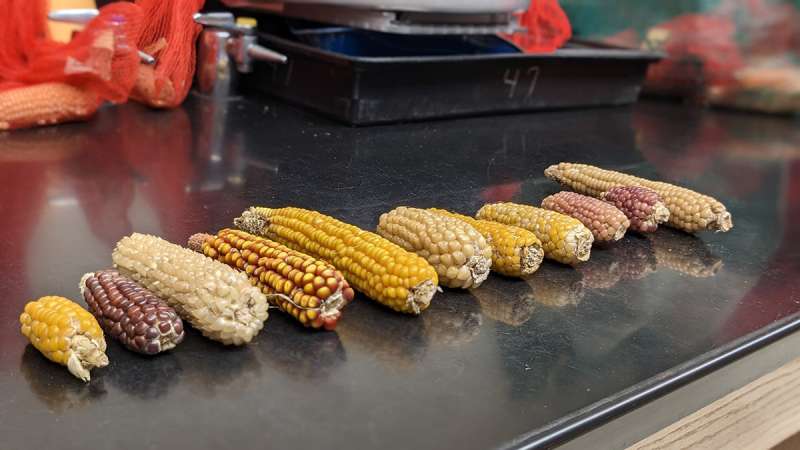This article has been reviewed according to Science X's editorial process and policies. Editors have highlighted the following attributes while ensuring the content's credibility:
fact-checked
trusted source
proofread
Study reveals genetic secrets of America's favorite snack

In its simplest form, popcorn is pretty uncomplicated. Most supermarket varieties offer the choice of two kernel colors, yellow or white, and two kernel shapes, pointed or pearl. When popped, the flake typically expands into one of two shapes: mushroom or butterfly. But there's more to popcorn than meets the eye. New research from the University of Illinois Urbana-Champaign reveals a wealth of untapped diversity lurking in popcorn's genetic code.
Analyzing 320 publicly available popcorn lines, crop sciences researchers found variation at more than 308,000 locations across the genome. This diversity may or may not translate into more popcorn variety for consumers, but some of the differences could be important for improving the agronomic performance of the crop.
"This could be helpful if popcorn companies wanted to bring in material to diversify their germplasm, which is super important for things like disease resistance and herbicide tolerance. More work has to be done to identify traits of interest, but this dataset opens up those possibilities," says study co-author Tony Studer, associate professor and popcorn breeder in the Department of Crop Sciences, part of the College of Agricultural, Consumer and Environmental Sciences at Illinois.
Studer's team documented the genetic differences in a process known as genotyping by sequencing, which narrows the focus of genetic sequencing efforts to the most information-packed parts of the genome. Differences, or polymorphisms, among corn lines occurred at the level of single nucleotides, the building blocks of DNA.
Popcorn populations
Having identified hundreds of thousands of differences, the team could then group corn lines by patterns of single nucleotide polymorphisms (SNPs), allowing the researchers to make inferences about relatedness. According to the analysis, North American popcorns fall into two groups: One primarily composed of yellow pearl types, with white pointed and Latin American types falling into a second group.
"Grouping popcorn based on genetic similarities allows us to look at the diversity present in each group and better predict the performance of crosses between lines. In addition, if a gene is found to improve performance, knowing its group membership will help breeders incorporate it into their program, something I hope popcorn companies will take advantage of to improve their products both on the consumer side and the grower side," says Madsen Sullivan, doctoral student in crop sciences and the study's first author.
The results showed a high level of inbreeding among yellow pearl popcorns. That means lower genetic diversity and greater relatedness among that group. Although this has resulted in better popping traits, material from the other group will likely contain versions of genes that could be useful but are not present in the yellow pearl popcorns.
The analysis also provides a starting point from which to uncover popcorn's long history of movement across North America and the world. Studer says the first people to consume corn likely ate it popped, not buttered on the cob. He's working to trace popcorn's early origins in a follow-up study.
Demystifying popcorn's herbicide tolerance
With popcorn's genetic code spelled out, the researchers were eager to tackle a longstanding mystery related to herbicide application labels. Nicosulfuron has been killing weeds in cornfields since the early 1990s, but it's only labeled for yellow-kerneled hybrids; farmers are specifically warned against using it on white-kerneled popcorn.
"That was a red flag to me, because kernel color should have nothing to do with herbicide sensitivity," says co-author Marty Williams, USDA-ARS ecologist and affiliate professor of crop sciences at Illinois. "Kernel color is controlled by genes in a completely different part of the genome."
Williams worked with Studer's team to test 294 popcorn genotypes from both populations, the yellow pearl group and the white pointed and Latin American group; incidentally, neither group is exclusively yellow or white, despite their names. The researchers applied nicosulfuron to the test group as well as sensitive and tolerant popcorn and sweet corn hybrids as controls.
While nicosulfuron did injure more white-kerneled popcorns, the effect had nothing to do with kernel color itself. Instead, nicosulfuron sensitivity correlated with genetic heritage and population structure. The pointed and Latin American types were more sensitive than yellow pearls. In dent corn, nicosulfuron is detoxified by a gene known as nsf1. The researchers immediately looked for the same gene in popcorn, assuming it would be active in the tolerant genotypes.
"We expected nsf1 to come up in popcorn, but instead we found a whole different set of genes that seemed to relate to nicosulfuron tolerance," Studer says. "That opens up the possibility of an alternate mechanism for herbicide tolerance in popcorn, and we're planning to follow up on that."
Next steps
Williams recommends popcorn breeders use this research to improve tolerance to nicosulfuron, and perhaps other herbicides, in their existing and new cultivars. Then herbicide labels ultimately could be updated to reflect tolerance throughout the crop, regardless of kernel color.
Could the results of the genome study improve popcorn's agronomic traits? Studer says it will take more work to screen the dataset for desirable traits, but eventually elite popcorn lines could be developed and marketed by popcorn companies.
More information: Madsen Sullivan et al, Genetic diversity of North American popcorn germplasm and the effect of population structure on nicosulfuron response, Crop Science (2023). DOI: 10.1002/csc2.21039
Provided by University of Illinois at Urbana-Champaign



















